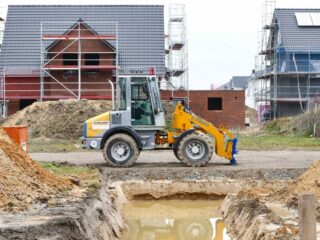
Logistics may not capture as many headlines as architectural renderings or ribbon-cutting ceremonies, yet it is often the hidden lever that makes or breaks profitability on property development projects.
Poorly timed material deliveries, insufficient lay-down space, or a last-minute scramble for warehouse capacity can erode margins just as surely as change-order overruns. This guide walks you through a two-phase logistics framework from groundbreaking through occupancy.
Construction-Phase Logistics Planning
Construction logistics covers the sequencing, movement, and storage of materials, equipment, and people on-site. It’s a complex discipline that orchestrates resource flow to ensure they are at the right place at the right time.
While overall U.S. construction productivity has stagnated, well-coordinated logistics can significantly boost project efficiency, lower build costs, and shorten time-to-market.
Core Elements of a Site Logistics Plan
A robust site logistics plan begins with a focus on site layout and organization. This involves defining crane swing radii, lay-down areas, and exclusion zones on an updated site map. It is also important to reserve flexible buffer space for unforeseen material spikes.
Material management is another critical component, where practices like just-in-time (JIT) delivery windows and asset tracking with QR codes reduce idle time.
Furthermore, transportation and access must be planned by securing road-use permits early and modeling truck turning radii. For congested urban sites, establishing off-site staging areas can alleviate on-site bottlenecks.
Step-by-Step Guide—Building an Effective Logistics Plan
Building a successful plan follows a logical sequence. First, identify key logistics milestones that align with your project’s critical-path schedule. Second, map all site constraints, including street widths, overhead power lines, and neighboring properties. Third, select the appropriate equipment and transport modes for your materials.
This step is crucial, as moving oversized components like modular building sections or large HVAC chillers requires specialized planning.
For these challenges, coordinating permits, route surveys, and securing the right equipment for safe delivery often involves leveraging specialized expertise. Firms such as Titan Worldwide, that specialize in heavy haul trucking logistics, can be instrumental in managing these complex requirements.
After transportation is sorted, designate material flow routes and emergency egress points, then set JIT delivery windows to balance efficiency with risk. Finally, assign responsibilities and test the plan through tabletop drills before implementation.
Ideal Practices for Managing Site Logistics On-Site
Effective on-site management hinges on modern tools and strong relationships. Keep all drawings, delivery schedules, and logistics plans in a shared cloud repository for universal access.
Integrating digital construction management workflows provides real-time visibility into material movements. It is also beneficial to build proactive relationships with local authorities, as this can often expedite the permitting process for road closures or oversized deliveries.
Adapting Logistics for Different Project Types
A one-size-fits-all approach to logistics does not work. High-rise urban infill projects demand micro-staging areas and night deliveries, while a sprawling suburban industrial park allows for larger lay-down zones.
| Key Insight: Effective construction-phase logistics is not just an operational task but a strategic lever. Proactive planning directly protects your project timeline and budget from costly delays, ensuring a smoother path from groundbreaking to completion. |
Long-Term Logistics Real-Estate Strategy

Once construction is complete, the focus shifts to long-term operational logistics. The process starts with defining your project strategy, including throughput requirements, labor pool availability, and proximity to transportation links.
This is followed by market research to benchmark rents, vacancy rates, and labor costs. Decision support tools help quantify the best options, leading to leveraged negotiations for favorable terms.
Types of Logistics Real-Estate Assets & Key Features
The type of logistics asset you choose depends on your operational needs. Inner-city logistics parks are ideal for last-mile delivery, while large-scale parks with rail spurs suit national distribution hubs. It’s also important to distinguish between distribution centers focused on throughput and warehouses focused on storage density.
Specialty warehouses accommodate unique needs like cold storage or fully automated robotic systems.
Trends Driving Warehouse Demand
Several trends are shaping the logistics real estate landscape. Onshoring and nearshoring continue to increase domestic demand for industrial space. Automation is also a major driver, requiring clear heights of 36 feet or more to operate effectively.
Additionally, ESG mandates are pushing for sustainable features like solar rooftops and electric-vehicle charging stations.
Benefits of Partnering With an Experienced Logistics Real-Estate Broker
Navigating the industrial real estate market is best done with an expert partner. An independent, tenant-focused broker can translate your operational requirements into specific real-estate terms.
They maintain proprietary market data and orchestrate sophisticated site-selection analytics to identify optimal locations. Their deep supply-chain fluency helps secure operational essentials that reduce your landed cost per unit shipped.
| Key Insight: Today’s warehouse selection must be forward-looking. Prioritizing features like higher clear heights for automation and ESG compliance is essential for securing long-term asset value and tenant demand. |
Safety and Efficiency on Large Sites
On a sprawling jobsite or inside a massive distribution center, safety and micro-mobility are paramount. Cold-weather jobsites expose workers to risks like frostbite, so investing in quality personal protective equipment (PPE) such as heated gloves can maintain productivity.
Likewise, equipping supervisors with a compact moped scooter fleet can speed up inspections in large warehouses while reducing congestion in busy aisles.
Putting Your Plan into Action
From the first load of rebar delivered to the site to the final lease signed on your warehouse, integrated logistics planning is the thread that holds projects together. By using the two-phase blueprint outlined above, you can build a structured approach to managing both the construction phase and long-term logistics. A strategy backed by data, digital tools, and the right partners will de-risk your next development project and protect your bottom line.












